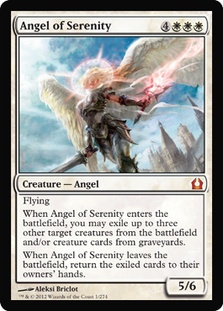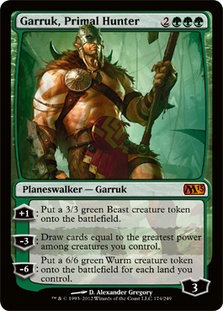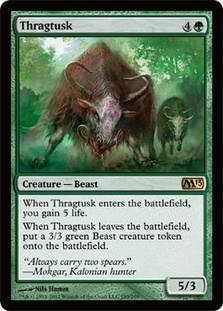Learning a new Standard format is tough. A large percentage of the format is made up of brand new cards. Some people look to Block Constructed decks to get an idea of what will define the format, but in my experience, the strategies defining Block rarely carry over. I was excited to get started, but without access to Magic Online I had to rely on the decks my friends and I built and the games we played to get format experience. I wanted to get a head start so I could understand which cards were good and which deck to acquire first on Magic Online.
After the StarCityGames.com Standard Open in Cincinnati, we had an idea of the kinds of decks we wanted to beat. The gauntlet we built was a mixture of the things we had learned and the better decks we had combined with what seemed to be the anchors of the format from Cincinnati. We built three different Zombie decks, Jund, G/W, and U/W/R Control. You can find the lists for these decks here. In addition to these, we also had a G/W Humans deck and a Junk Reanimator deck.
Creatures (29)
- 4 Champion of the Parish
- 4 Avacyn's Pilgrim
- 3 Thalia, Guardian of Thraben
- 4 Silverblade Paladin
- 4 Sublime Archangel
- 4 Knight of Glory
- 4 Fencing Ace
- 2 Precinct Captain
Lands (23)
Spells (8)

Creatures (15)
Planeswalkers (4)
Lands (23)
Spells (18)

Our G/W deck was ok, but it wasn’t as good as the Cincinnati one. Our build was faster and had more synergy, but that isn’t as important as having better individual cards, especially against U/W/R Control. The Reanimator deck, on the other hand, was performing very well. Over ten-game sets it was 7-3 against Jund Zombies and G/B Zombies, 8-2 against Jund, and 6-4 against B/R Zombies, U/W/R Control, and G/W. We increased our sample sizes and varied our lists, but the numbers didn’t really change all that much.
Graveyard-based strategies are usually better before sideboarding, and these were the only games we were testing. I didn’t think this was going to be the case for this particular Reanimator deck though. In a lot of the games you don’t even rely on your graveyard, and most of the time you end up just hard casting your Angel of Serenity. Previous Reanimator decks, including the four-color version from Cincinnati, all relied upon Faithless Looting. If your opponent had graveyard hate, Faithless Looting was card disadvantage, and this made you vulnerable. For this reason, I used to side out a couple of Lootings and a couple of Unburial Rites, but this just made the deck less powerful and consistent.
The new Junk deck doesn’t have Looting at all, so the only card that is really switched off by graveyard hate is Unburial Rites. Mulch, Grisly Salvage and Lingering Souls all get a little worse but are still fine. Aside from slowing you down, I didn’t think that graveyard hate would actually be that effective.
This was as far as our testing got before Return to Ravnica became Magic Online legal. The first thing I did was acquire the cards for Reanimator. I managed to do this within the first day of the Prereleases, and then I got to testing. At first I was winning most of my matches. There were a few games where I mulliganed into bad hands or just drew all the wrong cards, but aside from that I was doing very well. I started tuning the sideboard and working out my plans.
Sideboard:
1 Garruk, Primal Hunter
4 Centaur Healer
3 Abrupt Decay
2 Deathrite Shaman
1 Cremate
2 Oblivion Ring
2 Duress
There is a cliche that some of my good friends use for my deckbuilding process. I’ll be winning a lot with a new deck and telling them all about it, but at some point I go on a losing spree. This is when they say, "The honeymoon is over." This happens surprisingly often. Sometimes it levels out if the deck is actually good and I go back to winning. But sometimes the deck just isn’t very good and my winning percentage was just positive variance. This is now what I believe happened with Reanimator.
Rather than the mulligans and the bad hands being the minority of draws, they were now the majority. The deck just had too many bricks. The curve was too high. Unburial Rites just does nothing sometimes, and a lot of the other cards do very little without it. Thragtusk is a fantastic card, but if you don’t get to five mana, it’s just another brick stuck in your hand. I won two of the last eleven matches I played before finally calling it quits. It was doing fantastically powerful things but not quickly or consistently enough.
Nevertheless, my time wasn’t completely wasted. I learned that Angel of Serenity is amazing. I also knew that I wanted to play Garruk, Primal Hunter, and Thragtusk if at all possible. Garruk seems like the perfect card for this format. With a Thragtusk he will usually draw you five cards, and even without one he will draw enough to find some serious action. He is a threat against control, and 3/3 bodies are a good size to be fighting aggro.
It was at this point that I started digesting the StarCityGames.com Standard Open results from Providence. The event had just concluded, and it seemed to demonstrate a progression in the format. Midrange was coming out on top over both aggressive and control archetypes. The deck I liked most was the Jund deck played by Elliott Volchesky. I didn’t like the Strangleroot Geists and Wolfir Avengers that were in Lauren Nolen list from the previous week, so when Elliott cut them and still placed well I was ready to give the deck a whirl myself.
After only a couple of games, I felt that the deck was good but just not quite right. Garruk, Primal Hunter seemed like the perfect addition. I also didn’t like Bonfire of the Damned or the third Rakdos’s Return. This is my current list:
Creatures (11)
Planeswalkers (5)
Lands (24)
Spells (21)

This is a good deck. It has a lot of great cards, is consistent, and is powerful. It has answers to most of the format’s questions and enough good questions if you aren’t forced to answer theirs. However, it doesn’t have Angel of Serenity, and it can’t beat a Sigarda, Host of Herons. Sometimes you are too removal heavy, and sometimes you are just too removal light. Most of your removal is sorcery speed, and the format seems to be adjusting to this. I liked Jund and was doing well with it, but my deckbuilding twitch had not yet been satisfied. I felt like I could do better.
Creatures (18)
- 2 Borderland Ranger
- 1 Avacyn's Pilgrim
- 4 Huntmaster of the Fells
- 4 Restoration Angel
- 4 Thragtusk
- 3 Angel of Serenity
Planeswalkers (3)
Lands (24)
Spells (15)

This was built using the Jund shell. The four Restoration Angels, two Borderland Rangers, and the Avacyn’s Pilgrim were originally a Selesnya Keyrune, two Selesnya Charms, and a full set of Pillar of Flame. I made these changes after testing with Restoration Angel and have not looked back. After Restoration Angel was added, it was not long before I added the two Borderland Rangers for extra synergy. The Avacyn’s Pilgrim was an attempt to be playing a fifth Farseek, but in reality it is much worse. With only six untapped green sources, it is rarely a turn 1 play. It doesn’t really fix your mana and doesn’t survive removal. Farseek is extremely important, so adding the extra accelerant, even if it is a bad one, seemed worthwhile.
Taking out the early removal was a result of how well the deck was playing against aggro. You will usually fall a little behind in the early game, but once you start Blinking a Huntmaster or a Thragtusk, you’ll pull ahead or at least just buy enough time for Angel of Serenity to take over. So far I have been beating everything. Not only have I been winning my games, but all of my matchups have felt favorable. I’m only 27 matches in, but I won 24 of them. The pessimist in me would call it classic honeymoon syndrome.
Zombies
+4 Centaur Healer
+2 Pillar of Flame
+1 Terminus
-3 Garruk, Primal Hunter
-2 Bonfire of the Damned
-2 Selesnya Charm
The plan here is take out some of the late game power in Garruk and replace it with more cards that help you survive in the early game. Selesnya Charm and Bonfire of the Damned are poor, whereas Pillar of Flame is excellent. Huntmaster, Thragtusk, and Restoration Angel will all get you enough value that even without Garruk you will have no problem putting the game away once you have stabilized.
G/W
+2 Terminus
+1 Oblivion Ring
-1 Garruk, Primal Hunter
-2 Selesnya Charm
Any deck playing Rancor and Silverblade Paladin is capable of stealing games from nowhere, but overall this matchup feels highly favorable. Terminus gives you a safety net and replaces the largely irrelevant Selesnya Charms. If they have a lot of Sublime Archangels or Wolfir Silverhearts, I would be tempted to leave them in at the expense of a couple of Huntmasters.
Jund
+3 Sigarda, Host of Herons
+1 Garruk, Primal Hunter
+1 Oblivion Ring
-2 Bonfire of the Damned
-4 Huntmaster of the Fells
This matchup is all about going big—Thragtusk mirrors usually are. Their trumps are Rakdos’s Return and Olivia Voldaren, whereas you’ll win with Restoration Angel, Garruk, and Angel of Serenity. After sideboarding, Sigarda will rip them apart. Their only real answer is Olivia, and you have a lot of ways of killing her. Siding out Huntmasters might not seem like a great idea at first, but it is either easily answered or not all that effective. It just doesn’t go big enough.
Control
+2 Thundermaw Hellkite
+1 Garruk, Primal Hunter
+1 Oblivion Ring
-2 Bonfire of the Damned
-2 Mizzium Mortars
This is a total grind. You’re trying to do broken things while they’re trying to stop you. Prioritizing board presence limits the advantage they can squeeze out of Tamiyo and Jace. Without their planeswalkers, they have little chance to get through your superior card advantage.
Reanimator
+1 Garruk, Primal Hunter
+2 Thundermaw Hellkite
+1 Oblivion Ring
+2 Terminus
-2 Mizzium Mortars
-4 Huntmaster of the Fells
Talk about going big. This might be hard to believe, but you are actually favored going long. They will try and get an early Griselbrand, which you can’t really stop. You have a bunch of ways of dealing with it, and despite them drawing another seven, they don’t have all that many ways of actually killing you. Most builds aren’t playing Craterhoof Behemoth, and without one, they will be trying to kill you with Angels of Serenity, Thragtusks, and Lingering Souls. You are well equipped to deal with these. Garruk is an all-star and routinely draws you five cards. The game will usually end with a Bonfire for 6+ or repeated Blinking of Thundermaw Hellkites.
I hope you have enjoyed reading about my testing experiences with new Standard, and I urge you to give Naya Midrange a try.
As always, I look forward to your feedback and comments.
Dan Unwin
Sledgesliver on Magic Online



